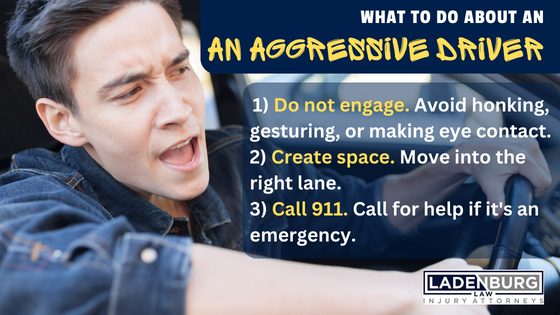Free Case Evaluation
(253) 272-5226Free Case Evaluation
(253) 272-5226Studies show that most of us have encountered an aggressive driver while on the road. While these incidents are common, they can feel personal and even scary when you’re the one experiencing it. Thankfully, there are a few strategies you can use to handle an aggressive driver. Of course, if you find yourself in a true emergency situation, call 911.
Before we talk about what the other driver is doing, ask yourself first if you are contributing to an unsafe situation. While aggressive driving is always wrong, some people’s buttons are more easily pushed. Studies show that there are a few common triggers for aggressive driving. These include:
If there is a way to correct your behavior, do so. Move into the right lane, give the driver some space, and put down the phone. While the other driver may be overreacting, do your part to not provoke the situation further.
When you engage an angry driver, you are adding fuel to the fire. And you really have no idea how large that fire may grow or hot it might burn. Studies show that a firearm is present in a about 37% of aggressive driving incidents. Do not underestimate the other driver’s potential to cause harm!
Here are some ways you can avoid engaging:
It may be incredibly tempting to respond when another driver is behaving poorly. Consider ahead of time what your “go to” response will be the next time you encounter an aggressive driver.

One of the most dangerous places you can be is directly in front of an angry driver. Work to remove yourself from this position as soon as possible.
Move to the right lane and allow the driver to pass. Do not attempt to follow them or engage in any way.
In some situations, you may want to pull over entirely. If so, take care where you do this. A busy parking lot, a police station or other well-lit, public space may work. Remember, sometimes a driver may be angry enough to want to pull over and engage with you further. Be careful to not put yourself in a vulnerable situation.
If the situation continues to escalate or you feel the driver is about to cause a wreck, call 911. Do your best to get vehicle information, including the license plate number. If there is a passenger in the car, have them do this so you can focus on driving. Above all, work to stay calm, taking deep breaths. Responding in an emotional, frantic way will only put you and your passengers in greater danger.
Incidentally, an emergency situation is one of the few exceptions to Washington’s distracted driving law. If you spot someone driving recklessly or aggressively? You won’t be fined for cell phone use in this instance.
On another note, don’t drive home if you’re being followed. Call 911 and drive to a crowded, public space or police station. Stay in your vehicle and avoid confronting the angry driver.
It’s easy to think about other people being aggressive drivers than ourselves. But we’ve all experienced frustration at a longer-than-normal commute, unexpected traffic, road construction, running late, or getting cut off. These frustrations can sometimes boil over in the way we present ourselves or even behave on the road. And sometimes, we may be unaware of our actions unless we take the time to self-reflect.
Here are a few ways you can keep your emotions in check when behind the wheel:
It never hurts to take a few deep breaths before getting behind the wheel. Make sure your attitude is in check to share the road with all kinds of drivers and scenarios. Are you prepared to be a polite and patient driver?
Remember, this isn’t about winning. It’s getting home safe to your family. Do all you can to keep that perspective when navigating an unsafe driver.
For more information on handling an aggressive driving situation, see the NHTSA, the DOL, and AAA websites.
In spite of your best efforts, sometimes bad things happen. If you’ve been the victim of someone’s road rage, our Tacoma attorneys at Ladenburg Law would like to hear about it. Please call us today for a no-fee, no-obligation quote.